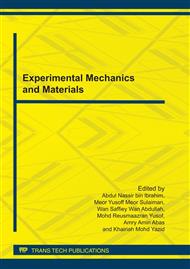[1]
Geng, J.P., Tan, K.B.C., and Liu, G. -R., Application of finite element analysis in implant dentistry: A review of the literature, Journal of Prosthetic Dentistry, 85(6), 585-598, (2001).
DOI: 10.1067/mpr.2001.115251
Google Scholar
[2]
Holmgren, E.P., Seckinger, R.J., Kilgren, L.M., and Mante, F., Evaluating parameters of osseointegrated dental implants using finite element analysis -a two-dimensional comparative study examining the effects of implant diameter, implant shape, and load direction, The Journal of Oral Implantology, 24(2), 80-88, (1998).
DOI: 10.1563/1548-1336(1998)024<0080:epoodi>2.3.co;2
Google Scholar
[3]
Matsushita, Y., Kitoh, M., Mizuta, K., Ikeda, H., and Suetsugu, T., Two-dimensional FEM analysis of hydroxyapatite implants: diameter effects on stress distribution, The Journal of Oral Implantology, 16 (1), 6-11, (1990).
Google Scholar
[4]
Teixeira, E.R., Sato, Y., Akagawa, Y., and Shindoi, N., A comparative evaluation of mandibular finite element models with different lengths and elements for implant biomechanics, Journal of Oral Rehabilitation, 25(4), 299-303, (1998).
DOI: 10.1111/j.1365-2842.1998.00244.x
Google Scholar
[5]
Papavasiliou, G., Kamposiora, P., Bayne, S.C., and Felton, D.A., 3D-FEA of osseointegration percentages and patterns on implant-bone interfacial stresses, Journal of Dentistry, 25(6), 485-491, (1997).
DOI: 10.1016/s0300-5712(96)00061-9
Google Scholar
[6]
Cehreli, M., Duyck, J., De Cooman, M., Puers, R., and Naert, I., Implant design and interface force transfer. A photoelastic and strain-gauge analysis, Clinical Oral Implants Research, 15(2), 249-257, (2004).
DOI: 10.1111/j.1600-0501.2004.00979.x
Google Scholar
[7]
Fanuscu, M.I., Iida, K., Caputo, A.A., and Nishimura, R.D., Load transfer by an implant in a sinus-grafted maxillary model, International Journal of Oral and Maxillofacial Implants, 18(5), 667-674, (2003).
Google Scholar
[8]
Kim, W.D., Jacobson, Z., and Nathanson, D., In vitro stress analyses of dental implants supporting screw-retained and cement-retained prostheses, Journal of Oral Rehabilitation, 29(4), 394-400, (2002).
DOI: 10.1097/00008505-199908020-00006
Google Scholar
[9]
Brosh, T., Pilo, R., and Sudai, D., The influence of abutment angulation on strains and stresses along the implant/bone interface: comparison between two experimental techniques, The Journal of Prosthetic Dentistry, 79(3), 328-334, (1998).
DOI: 10.1016/s0022-3913(98)70246-x
Google Scholar
[10]
Gross, M.D., Nissan, J., and Samuel, R., Stress distribution around maxillary implants in anatomic photoelastic models of varying geometry. Part I, Journal of Prosthetic Dentistry, 85(5), 442-449, (2001).
DOI: 10.1067/mpr.2001.115253
Google Scholar
[11]
Gross, M.D., and Nissan, J., Stress distribution around maxillary implants in anatomic photoelastic models of varying geometry. Part II, Journal of Prosthetic Dentistry, 85(5), 450-454, (2001).
DOI: 10.1067/mpr.2001.115252
Google Scholar
[12]
SAWBONES Worldwide Leaders in Orthopaedic and Medical Models, A Division of Pacific Research Laboratories, Inc., 72-73, (2008).
Google Scholar


